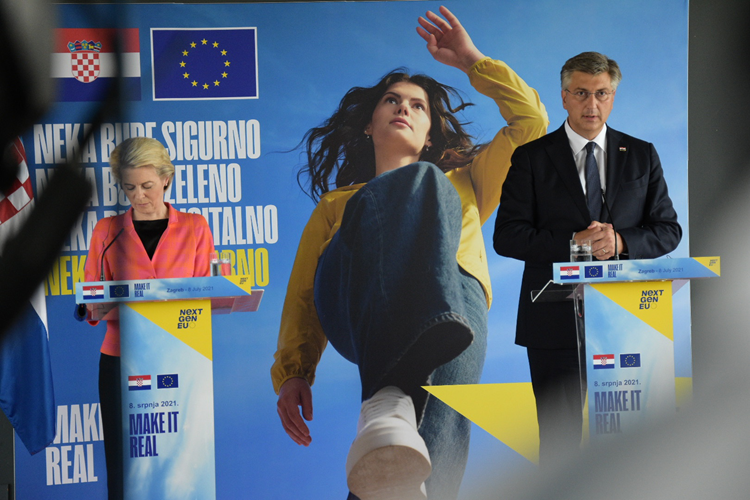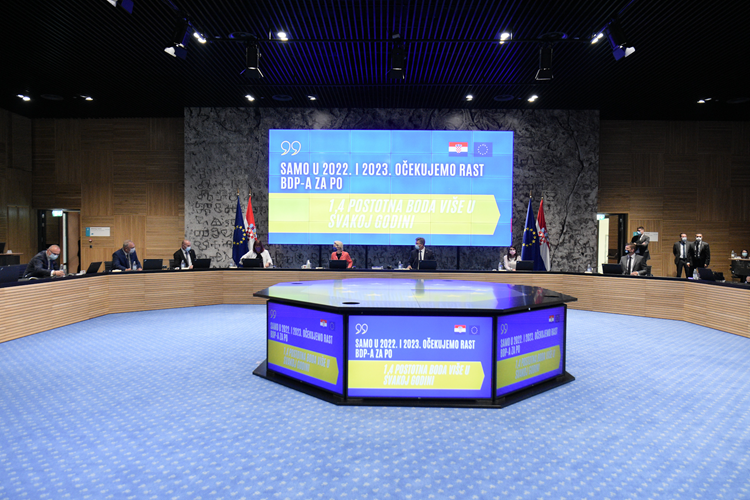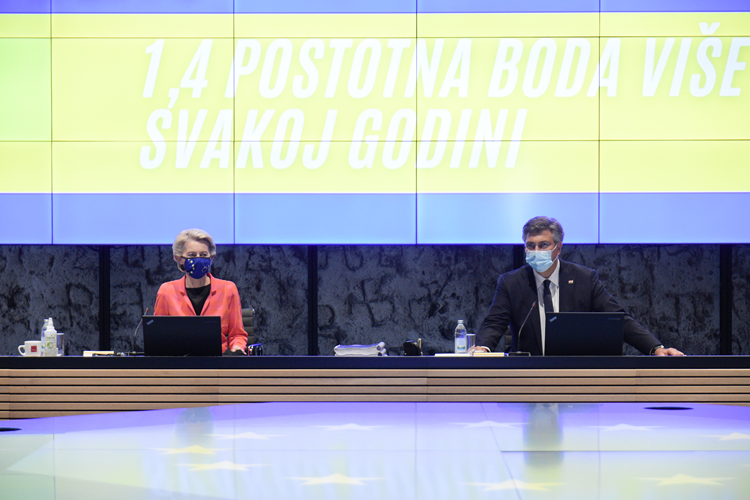- Published: 08.07.2021.
Thanks to it's EU membership, Croatia has 30 billion € at it's disposal in this decade to invest in economic growth
The European Commission on Thursday gave a positive assessment of Croatia's recovery and resilience plan, worth €6.3 billion, which could significantly boost the country's Gross Domestic Product and create 21,000 new jobs by 2026.
The positive assessment was personally delivered by the visiting EC President Ursula von der Layen to Prime Minister Andrej Plenković in Zagreb on Thursday afternoon.
The greenlight from Brussels is an important step towards the EU disbursing funds in grants and loans under the Recovery and Resilience Facility (RRF).
"This is an important step towards the EU disbursing €6.3 billion in grants under the Recovery and Resilience Facility (RRF). This financing will support the implementation of the crucial investment and reform measures outlined in Croatia's recovery and resilience plan. It will play a key
role in helping Croatia emerge stronger from the COVID-19 pandemic," says the Commission.
Under the European Commission's estimates, Croatia's recovery and resilience plan could help rise the national economy by 1.5% in 2021, an additional 2.5% in each of the next four years, and by 2.9% in 2026.
In the long-term, over the next 20-year period, the plan can have a positive impact of 1.1% on the growth of GDP, without the effects of structural reforms which are supposed to increase Croatia's GDP by 15% over a 20-year period, according to a statement made by an official of the European Commission at a news conference in Brussels.
€818 million to Croatia in prefinancing
After the Commission today adopted a proposal for a decision to provide €6.3 billion in grants to Croatia under the RRF, the document was forwarded to the European Council which will now have, as a rule, four weeks to adopt the Commission's proposal. The Council's approval of the plan would allow for the disbursement of €818 million to Croatia in prefinancing. This represents 13% of the allocated grant amount for Croatia.
The EC says that it "will authorise further disbursements based on the satisfactory fulfilment of the milestones and targets outlined in the Council Implementing Decision, reflecting progress in the implementation of the investments and reforms."
The bulk of the funding, that is about 700 million annually, will be disbursed in the first three years each.
Croatia's RRP has met all the criteria, such as that at least 37% of the allocations are spent on climate targets and at least 20% on digital transformation. Furthermore, none of the measures should adversely impact the environment.
"The Commission's assessment finds that Croatia's plan devotes 40% of its total allocation to measures that support climate objectives. These include reforms and investments to promote the uptake of renewable energy, energy efficiency and post-earthquake reconstruction of buildings and sustainable mobility. Climate change adaptation measures include improved management of water resources and flood protection measures. The plan will also enhance the rich biodiversity in Croatia through the restoration of rivers, floodplains and lakes. Investment support schemes will support businesses, including SMEs, in their green transition," according to the Commission's press release.
The Commission's assessment of Croatia's plan finds that it devotes 20% of total expenditure to measures that support the digital transition.
"This includes investments and reforms to support gigabit connectivity, the digitalisation of public administration, transport, the judicial system and higher education. It also provides for increasing the national broadband coverage to reduce the urban-rural digital divide and help businesses, including SMEs, adapt their operations to the digital environment thereby increasing their competitiveness."
Croatia's plan consists of 21 components
Croatia RRP is made up by 21 components plus a horizontal initiative referring to the post-quake reconstruction of buildings.
There are 22 measures envisaging 76 reforms and 146 investments, and all those measures envisage 371 key stages and targets.
Economy - biggest component
The biggest component of the plan is Economy and €3.4 billion is planned for this purpose.
Education, Science and Research follows with about a billion euros. Health is highlighted as the third biggest component with €340 million, followed by Labour Market and Social Protection (€280 million).
Key measures to secure Croatia's green transition
When it comes to energy efficiency and post-earthquake reconstruction of buildings, renovating at least 225,000 square metres of residential buildings and 593,000 square metres of public buildings is planned with €789 million forecast for that purpose.
Low-carbon energy transition includes modernising energy infrastructure to connect 1,500 MW of renewable energy, supporting investments for the production of advanced biofuels and renewable hydrogen, financing innovative carbon capture and storage projects, and €658 million will be tapped for that purpose
Croatia plans to improve sustainable mobility by upgrading railway lines, autonomous electric taxis with supporting infrastructure adapted for people with disabilities, installing 1,300 charging stations for electric vehicles, introducing zero emission vehicles and vessels, and this allocation is set at €728 million.
20% investments supports digital objectives
It envisages digital transition of the public administration, digital connectivity of rural areas and digitalisation of higher education.
Concerning increasing the efficiency of the public sector and the justice system, the document envisages introducing new wage and work models in the civil service, incentivising the merger of local government administrations, strengthening mechanisms for coordination and integration of public policies, improving the governance of state assets, reducing the backlog of pending cases and the length of court proceedings, and €200 million can be tapped for that purpose.
EC dismisses criticism about insufficient funds distributed to private sector
Following objections of private entrepreneurs in Croatia that not enough funds would be directed to the private sector, an official of the EC has told Hina that instead of focusing on how much would be distributed to the private sector, it would be more useful to see how the money will be spent.
A considerable share will end up in private enterprises as they will take part in the implementation of investments and projects envisaged by Croatia's NRRP, say representatives of the EC.
As for the Rimac Automobili company, they explain that it will use funds under the Free Mobility Project.
This is a new project and does not amount to direct support to the company owned by Rimac, the EC official explained.
Commission President von der Leyen was quoted as saying that "with €6.3 billion, Croatia will be the largest recipient of the Recovery and Resilience Facility compared to the size of its economy."
Valdis Dombrovskis, Executive Vice-President for an Economy that Works for People, said that "this plan will put Croatia on the path to recovery after being hit hard both by the crisis and deadly earthquakes." The plan places a welcome focus on improving the justice system and fighting corruption. This plan will also help Croatia prepare its economy for a successful membership to the euro area, he added.
Text: Hina
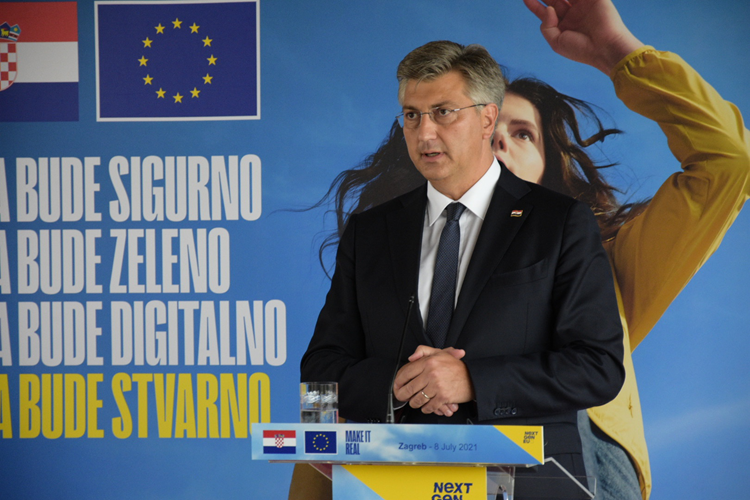
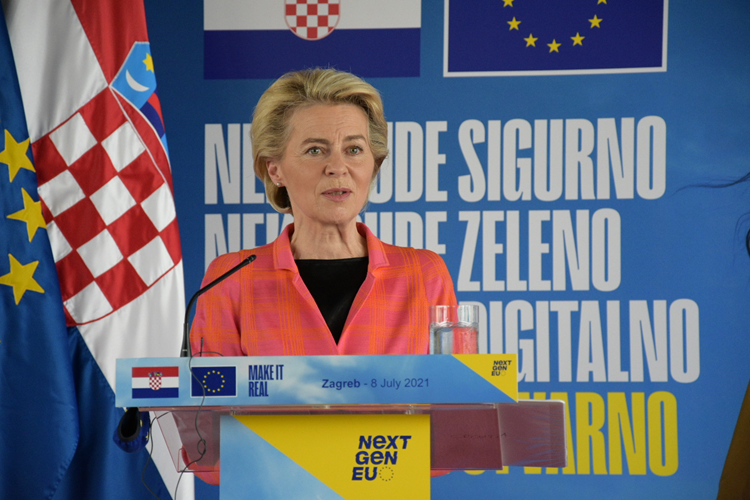
.png?width=750&height=500)
